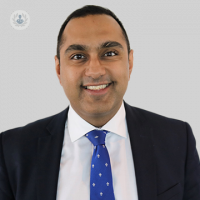Getting your ears pinned back – how does it work?
Escrito por:Like any other facial feature, ears come in all shapes and sizes, but for some they can appear as very prominent. This is caused by a problem in the development of their ear cartilage. For some, surgery provides an option to achieve natural-looking ears that do not protrude. Mr Raj Lakhani, a leading ENT surgeon, explains what otoplasty is, how it is performed and what to expect from the results.

What is otoplasty?
Otoplasty is a treatment for ears which protrude or are misshapen. It aims to reduce the prominence of protruding ears, usually on both sides, but sometimes it can affect just one ear. The problem is usually caused by failure of normal development of the cartilages which form the shape of the ear. This results in a failure of the normal ear fold and therefore leads to a prominent looking ear which sticks out. Sometimes there can also be problems with the earlobe. After a careful assessment of the specific abnormalities leading to the protruding and/or misshapen ear, a specific surgical treatment plan is designed to reshape the ear to achieve a natural and un-operated appearance.
Who is suitable for otoplasty?
On the whole, patients of any age group can be successfully treated with otoplasty if they have prominent ears. If a child or their parents are considering otoplasty, then waiting until they are around 7 or 8 years old is helpful so that the child can be involved in the decision-making process. Children of this age are also more likely to comply with the need to wear a head bandage for a week afterwards. Otherwise, there is no age restriction and adults of all ages, as well as children above the age of 5 or 6 can be successfully treated with otoplasty.
What does the procedure involve?
The procedure usually involves a general anaesthetic and on the whole is performed as a day case procedure (i.e. the patient goes home the same day as the surgery). There are two main techniques for reshaping prominent ears which are caused by cartilage problems. They are suture techniques and scoring techniques. Both techniques require a small incision on the back of the ear, and exposure of the underlying cartilage. I usually use cartilage suture techniques as I feel they give a safer, long-lasting result and avoid the risk of cartilage scoring techniques which have a slightly higher risk of cartilage break-down. Suture techniques can also can give a more natural, curved appearance.
It is possible to perform the procedure under local anaesthetic for older teenagers and adults. Patients are usually given antibiotics after the procedure and will be required to wear a head bandage for 5-7 days afterwards. There are usually no sutures to remove, or the stitches are dissolvable, apart from the permanent stitches which create the new shape of the ear which remain long-term under the skin.
There is also a relatively new technique which involves the placement of clips under the skin of the ear to reshape the ear cartilage. This technique is minimally-invasive but does mean that a permanent metal clip is placed under the skin and long-term experience with this technique is not as well-established as the cartilage suture and scoring techniques. The specific technique will be discussed with you at the time of surgery in more detail.
Does procedure involve any risks?
Otoplasty is a low-risk procedure. There may be some mild bleeding, but this isn’t usually a significant problem with ear reshaping surgery. Blood collecting under the skin and forming a haematoma is a risk with otoplasty and this collection of blood can get infected, although this risk is rare. Careful control of any bleeding at the time of surgery and ensuring that the head bandage is worn as advised after the procedure will reduce this risk.
There is a small chance of the cartilage becoming infected and you may be given antibiotics after the procedure to reduce this risk. If you develop pain, high fevers or discharge from the wound, contact your surgeon immediately, but this risk is extremely low.
The other risks to talk about are that you may still notice some difference between each ear, as it is very difficult to make each side look exactly the same. The chances of there being a big difference which is noticeable to other people is extremely low, however.
How long do results last for?
On the whole, the results from otoplasty are long-lasting. The stitches used in the suture technique of otoplasty are permanent. There is a tiny chance that these sutures can spring open, either over time or with trauma to the ear, but this is very unusual. The rate of revision surgery needed for otoplasty where the original surgery was conducted by a suitably trained surgeon with an interest in otoplasty is very low.
If you are interested in finding out more about otoplasty either for yourself or for your child, make an appointment with an expert.


